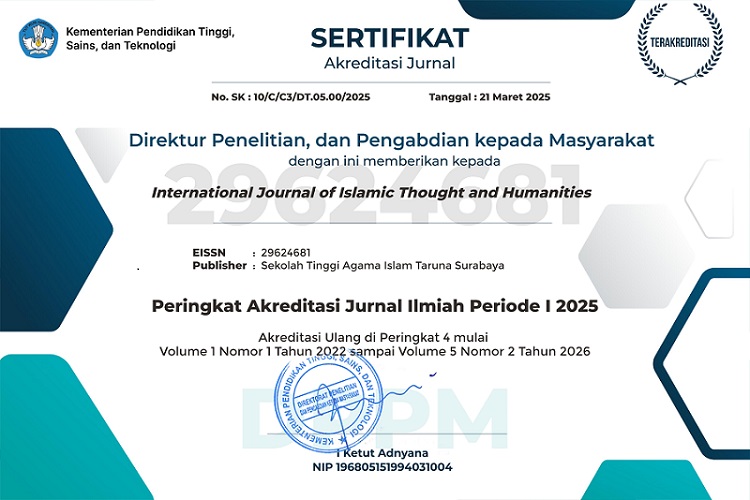The Relationship Leadership Style, Stress and Work Motivation with Organizational Commitment of Teachers of Children with Special Needs in Special Schools in Jambi Province
DOI:
https://doi.org/10.54298/ijith.v2i2.146Keywords:
Leadership Style,, Stress,, Work Motivation, Organizational CommitmentAbstract
organizational commitment of teachers of children with special needs in special schools, both partially and simultaneously. This research is quantitative research using a survey method carried out at State Special Schools in Jambi Province. The population is 106 people and the sample uses random sampling. The hypothesis in this research is: leadership, stress, work motivation and organizational commitment of teachers of children with special needs have a significant relationship, both partially and simultaneously, to Teacher Organizational Commitment. Hypothesis testing uses Pearson Product Moment Correlation technique analysis and multiple regression, with an alpha significance level of 5 percent (α=0.05). This research produced findings in detail, there is a direct relationship between leadership style (X1), stress (X2), and work motivation (X3) with organizational commitment Teacher of Children with Special Needs. Based on the results of analytical calculations, the calculated t value was obtained (29.065). >t table (2.68), so H0 is rejected and H1 is accepted. Leadership style, stress and work motivation have a significant relationship with the organizational commitment of teachers of children with special needs. Based on the research findings, it can be concluded that the variables of leadership style, stress and work motivation make a significant contribution to the organizational commitment of teachers of children with special needs.
Downloads
References
Banihashem, S. K., Noroozi, O., den Brok, P., Biemans, H. J. A., & Kerman, N. T. (2023). Modeling teachers’ and students’ attitudes, emotions, and perceptions in blended education: Towards post-pandemic education. International Journal of Management Education, 21(2), 100803. https://doi.org/10.1016/j.ijme.2023.100803
Chodzirin, M. (2016). Pemanfaatan Information and Communication Technology bagi Pengembangan Guru Madrasah Sub Urban. Dimas: Jurnal Pemikiran Agama Untuk Pemberdayaan, 16(2), 309. https://doi.org/10.21580/dms.2016.162.1095
Darmadi, H. (2015). Tugas, Peran, Kompetensi, Dan Tanggung Jawab Menjadi Guru Profesional. Jurnal Edukasi, 13(2), 161–174.
Elsha, S. (2022). Pengaruh Kepemimpinan Kepala Sekolah dan Stress Kerja Terhadap Komitmen Guru Dalam Pemeblajaran Daring SLBN Jakarta Utara. Jurnal Pendidikan Dasar Setiabudhi, 15(2), 1–23. https://stkipsetiabudhi.e-journal.id/jpds/article/view/126
Fathurrochman, I., Danim, S., Anwar AB, S., Kurniah, N., & Hajja Ristianti, D. (2021). Theoretical Review of the Implementation Islamic Boarding School Curriculum Management in Indonesia. International Journal of Education Research and Development, 1(1), 1–15. https://doi.org/10.52760/ijerd.v1i1.2
Gondwe, M., & Longnecker, N. (2015). Scientific and Cultural Knowledge in Intercultural Science Education: Student Perceptions of Common Ground. Research in Science Education, 45(1), 117–147. https://doi.org/10.1007/s11165-014-9416-z
Huang, L. Y. (2014). Learning to read with the whole language approach: The teacher’s view. English Language Teaching, 7(5), 71–77. https://doi.org/10.5539/elt.v7n5p71
Indonesia, D. A. R. (2015). Al-Quran Terjemahan. CV Darus Sunnah.
Indonesia, T. C. (2021). Sejarah Berdirinya PGRI, Kebangkitan Para Guru di Indonesia. CNN Indonesia. https://www.cnnindonesia.com/nasional/20210614164509-31-654184/sejarah-berdirinya-pgri-kebangkitan-para-guru-di-indonesia
Iskandar, W. (2019). Kemampuan Guru Dalam Berkomunikasi Terhadap Peningkatkan Minat Belajar Siswa di SDIT Ummi Darussalam Bandar Setia. AR-RIAYAH : Jurnal Pendidikan Dasar, 3(2), 135. https://doi.org/10.29240/jpd.v3i2.1126
Isnaini, L. (2016). Pengaruh gaya kepemimpinan dan budaya organisasi terhadap kinerja pegawai melalui motnasi kerja, studi pada kantor badan diklat daerah provinsi jambi. Universitas Terbuka.
Isroani, M. H. M. F., & Nguyen, V. C. (2023). Lembaran Ilmu Kependidikan Development of Prophetic Education Curriculum Management in Student Boarding Schools. Lembaran Ilmu Kependidikan, 52(1), 1–8. https://doi.org/https://doi.org/10.15294/lik.v52i1.43822
Kim, M. (2013). Cultivating teachers’ morality: The pedagogy of emotional rationality. Australian Journal of Teacher Education, 38(1), 12–26. https://doi.org/10.14221/ajte.2013v38n1.2
Kodrat, D. (2021). Industrial Mindset of Education in Merdeka Belajar Kampus Merdeka (MBKM). Jurnal Kajian Peradaban Islam, 4(1), 9–14. https://doi.org/10.47076/jkpis.v4i1.60
Kurniawan, S. (2019). Tantangan Abad 21 bagi Madrasah di Indonesia. Intizar, 25(1), 55–68. https://doi.org/10.19109/intizar.v25i1.3242
Kuswanto, E. (2015). Peranan Guru PAI dalam Pendidikan Akhlak di Sekolah. MUDARRISA: Journal of Islamic Education, 6(2), 194. https://doi.org/10.18326/mdr.v6i2.764
Latif, M. B. (2020). Sensus Penduduk September 2020. Badan Pusat Statistik. https://banjarkab.bps.go.id/news/2020/09/15/315/sensus-penduduk-september-2020.html
Lee, L., Kamenov, K., Fellinghauer, C., Sabariego, C., Chatterji, S., & Cieza, A. (2022). WHO Functioning and Disability Disaggregation (FDD11) tool: a reliable approach for disaggregating data by disability. Archives of Public Health, 80(1), 1–12. https://doi.org/10.1186/s13690-022-01001-2
Moghavvemi, S., Sulaiman, A., & Jaafar, N. I. (2018). The International Journal of Management Education Social media as a complementary learning tool for teaching and learning : The case of youtube A The International Journal of Social media as a complementary learning tool for teaching and learning : The ca. The International Journal of Management Education, 16(1), 37–42. https://doi.org/10.1016/j.ijme.2017.12.001
Mullins, L. J. (2010). Management & Organisational Behaviour. Ninth Edition Prentice Hall.
Nasrullah, Y. M., Wakila, Y. F., & Surachman, Y. T. L. (2022). Peran Literasi Teknologi Informasi Dan Komunikasi Pada Program Kuliah Kerja Nyata Di Masa Pandemi Covid-19. Jurnal Pengabdian Masyarakat, 01(01), 7–19.
Nurzannah, Ginting, N., & Setiawan, H. R. (2019). Implementation Of Integrated Quality Management In The Islamic Education System. Proceeding International Seminar on Islamic Studies, 1(1), 1–9.
Orland-barak, L., & Yinon, H. (2007). When theory meets practice : What student teachers learn from guided reflection on their own classroom discourse. Teaching and Teacher Education, 23, 957–969. https://doi.org/10.1016/j.tate.2006.06.005
Paetsch, J., Franz, S., & Wolter, I. (2023). Changes in early career teachers’ technology use for teaching: The roles of teacher self-efficacy, ICT literacy, and experience during COVID-19 school closure. Teaching and Teacher Education, 135(August), 104318. https://doi.org/10.1016/j.tate.2023.104318
Ridwan, M. (2018). Konsep Tarbiyah, Ta’lim Dan Ta’dib Dalam Al-Qur’an. Nazhruna: Jurnal Pendidikan Islam, 1(1), 26–44. https://doi.org/10.31538/nazhruna.v1i1.97
Robbins, S. P. (2010). Fundamentals of Human Resource Management, Tenth Edition. John Wiley & Sons.
Saleh, H. A., Shaker, E. G., & Author, C. (2021). Examining the Relationship between Teachers ’ Perception and their Receptivity of Curriculum Integration at American Schools in Dubai , UAE. 2(1).
Sibagariang, D., Sihotang, H., & Murniarti, E. (2021). Peran Guru Penggerak Dalam Pendidikan Merdeka Belajar Di Indonesia. Jurnal Dinamika Pendidikan, 14(2), 88–99. https://doi.org/https://doi.org/10.51212/jdp.v14i2.53 PERAN
Spalding, E., & Vegas, L. (2002). Demystifying Reflection : A Study of Pedagogical Strategies That Encourage Reflective Journal Writing. Teachers College Record, 104(7). https://doi.org/10.1111/1467-9620.00208
Sugiyono. (2019). Metode Penelitian Pendidikan (Kuantitatif, Kualitatif, Kombinasi, R&D dan Penelitian Pendidikan). Alfabeta.
Sulistyaningrum, D., Ridlo, R., & Hakim, A. (2020). Pendampingan Pembelajaran Siswa Melalui Teknologi Informasi Selama Pandemi Covid-19 : Studi Kasus KKN Tematik Covid-19 Mentoring Student Learning Through Technology Information During Pandemic Covid-19 : Case Studies Thematic KKN of Covid-19. ANDASIH Jurnal Pengabdian Kepada Masyarakat, 1(2).
Syafaruddin. (2003). Manajemen Mutu Terpadu Dalam Pendidikan Indonesia. Grasindo.
Taruk Allo, E. A. (2022). Penyandang Disabilitas di Indonesia. Nusantara: Jurnal Ilmu Pengetahuan Sosial, 9, 127–142.
Tichy, N. M., Fombrun, C. J., & DeVanna, M. . (1982). Strategic human resource management. Sloan Management Review, 23, 47–61.
Vieira, C. R., & Pedro, N. (2023). Weaknesses of ICT integration in the initial teacher education curriculum. Computers and Education Open, 5(October 2022), 100150. https://doi.org/10.1016/j.caeo.2023.100150
WHO. (2022). Strengthening the collection of data on disability. World Health Organization. https://www.who.int/health-topics/disability/collection-of-data-on-disability
Zahari MS, M., Yamali, F. R., & Irfani, A. (2020). Pengaruh Gaya Kepemimpinan Kepemimpinan dan Penempatan Pegawai Terhadap Motivasi Kerja Serta Dampaknya Pada Kinerja Pegawai di Biro Umum Setda Provinsi Jambi. J-MAS (Jurnal Manajemen Dan Sains), 5(2), 276. https://doi.org/10.33087/jmas.v5i2.195
Downloads
Published
How to Cite
Issue
Section
License
Copyright (c) 2023 Ridwan Ridwan, Mukhtar Latif; Risnita Risnita

This work is licensed under a Creative Commons Attribution-ShareAlike 4.0 International License.
Authors who publish with this journal agree to the following terms:
- Authors retain copyright and grant the journal right of first publication with the work simultaneously licensed under a Creative Commons Attribution-ShareAlike 4.0 that allows others to share the work with an acknowledgement of the work's authorship and initial publication in this journal.
- Authors are able to enter into separate, additional contractual arrangements for the non-exclusive distribution of the journal's published version of the work (e.g., post it to an institutional repository or publish it in a book), with an acknowledgement of its initial publication in this journal.
- Authors are permitted and encouraged to post their work online (e.g., in institutional repositories or on their website) prior to and during the submission process, as it can lead to productive exchanges, as well as earlier and greater citation of published work (See The Effect of Open Access).


















